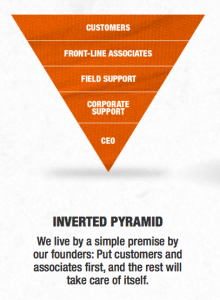I don’t know who first used the term “inverted pyramid.”
But I do know that the inverted pyramid is a powerful metaphor used by servant-leaders in the workplace.
The inverted pyramid is a way of approaching a company’s organizational chart – a way of thinking about one’s place in the hierarchy – in which the traditional leader, the CEO for example, is on the bottom, not the top.
The Home Depot certainly helped make the inverted pyramid famous. Here’s what The Home Depot founders, Bernie Marcus and Arthur Blank, have to say on the subject.

“If we broke down the management structure at The Home Depot on a blackboard, Bernie Marcus and Arthur Blank would be at the bottom; the stores would be at the top.
The people at the stores are the most important – after customers – because they interface with the customer, and since Berne and I really couldn’t begin to tell you how to wire a house, we are the least important when it comes to satisfying a customer,
The sign at the front entrance of our main offices in Atlanta says “Store Support Center.” Not “World Headquarters.” It is not a corporate ivory tower. It is truly the store support center. We want everybody in this building to know that we are here to support stores.
If a store calls anyone in the Store Support Center – from the chairman of the board and president to the janitor – our instruction to them is to stop what they are doing and take the store call . . .
In our inverted management structure, everyone’s career depends on how the associates in the stores function. If the people in the Store Support Center or divisional offices don’t feel like they are selling a product to customers in the stores, then they are part of a bureaucracy, and they will stymie the stores, not help them.
We don’t care what your job is. What have you done to help a customer in our stores today? What have done to sell a product to our customers? What have you done to bring a customer into our stores? What have you done to make a manufacturer want to sell to our company? You have a role, and if you don’t think you do, you don’t belong here. If you don’t know what your role is, you need to find out.”*
What do you think? Can you name some companies that take the inverted pyramid approach? Is that approach effective?
Let us know.
As always, we appreciate your views.
Thanks!
And download our latest ebook, Servant Leadership in the Workplace: A Brief Introduction. It’s free!
__________________________________
* Bernie Marcus & Arthur Blank, Built from Scratch: How a Couple of Regular Guys Grew The Home Depot from Nothing to $30 Billion (New York: Times Books 1999) 271-2.

